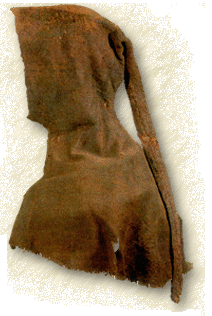
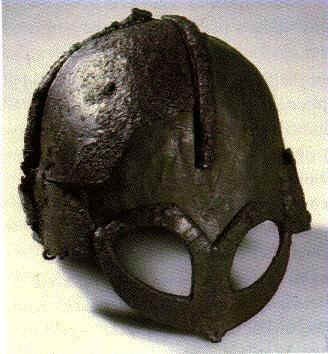 Anth
2140
Anth
2140

 Anth
2140
Anth
2140
The Norse in Greenland
11 Oct 2005
Dr. Kathryn Denning
Left: Viking Helmet, Gjermundbu, Norway, c. 900 AD. Right: Herjolfsnes Hood, Greenland c. 1300
Locating Ourselves Conceptually
Today, we will...
further examine a specific case study, that of the Norse in Greenland (following on from the video last class, The Lost Vikings of Greenland)
This case is specifically interesting because...
it shows how archaeology uses many lines of evidence, plus reasoned inference, to reach meaningful conclusions about the past
it is an unusual intersection of the Old World and the New World
it covers the relationship between cultures that write and cultures that don't
it's a mystery! The Norse made it to Greenland, and even to Canada..... but their settlements didn't last... They simply disappeared. What happened to them? Where did they go?
This case is also generally worth examining because...
archaeologists actually learn about human history one case (or site or culture) at a time. Then we put these cases together to see the 'big picture' we're learning about in this course.
it might have specific relevance for us today in the 21st century... as we shall see.
Locating ourselves in space...
North America
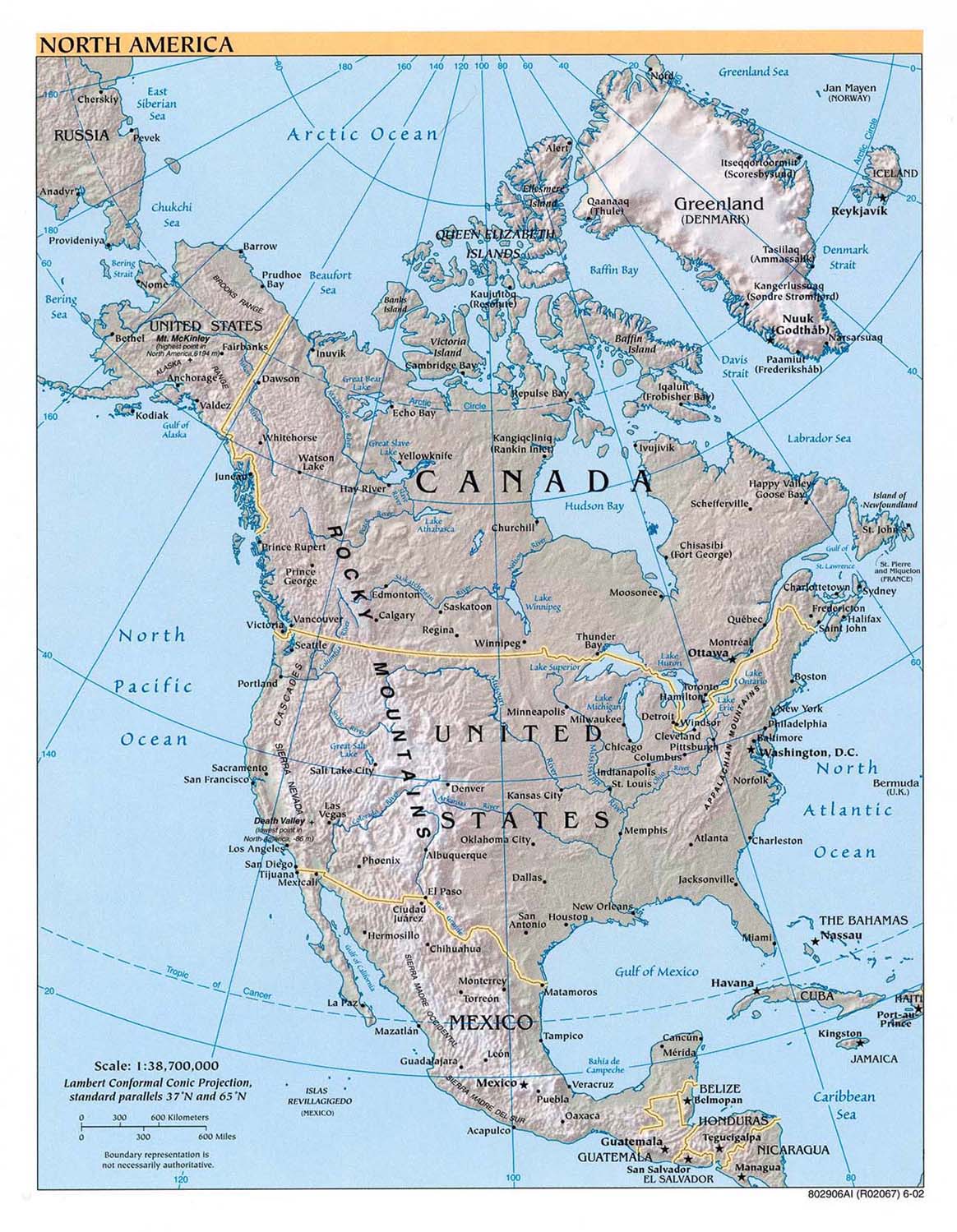
http://www.lib.utexas.edu/maps/americas/north_america_ref02.jpg
Europe
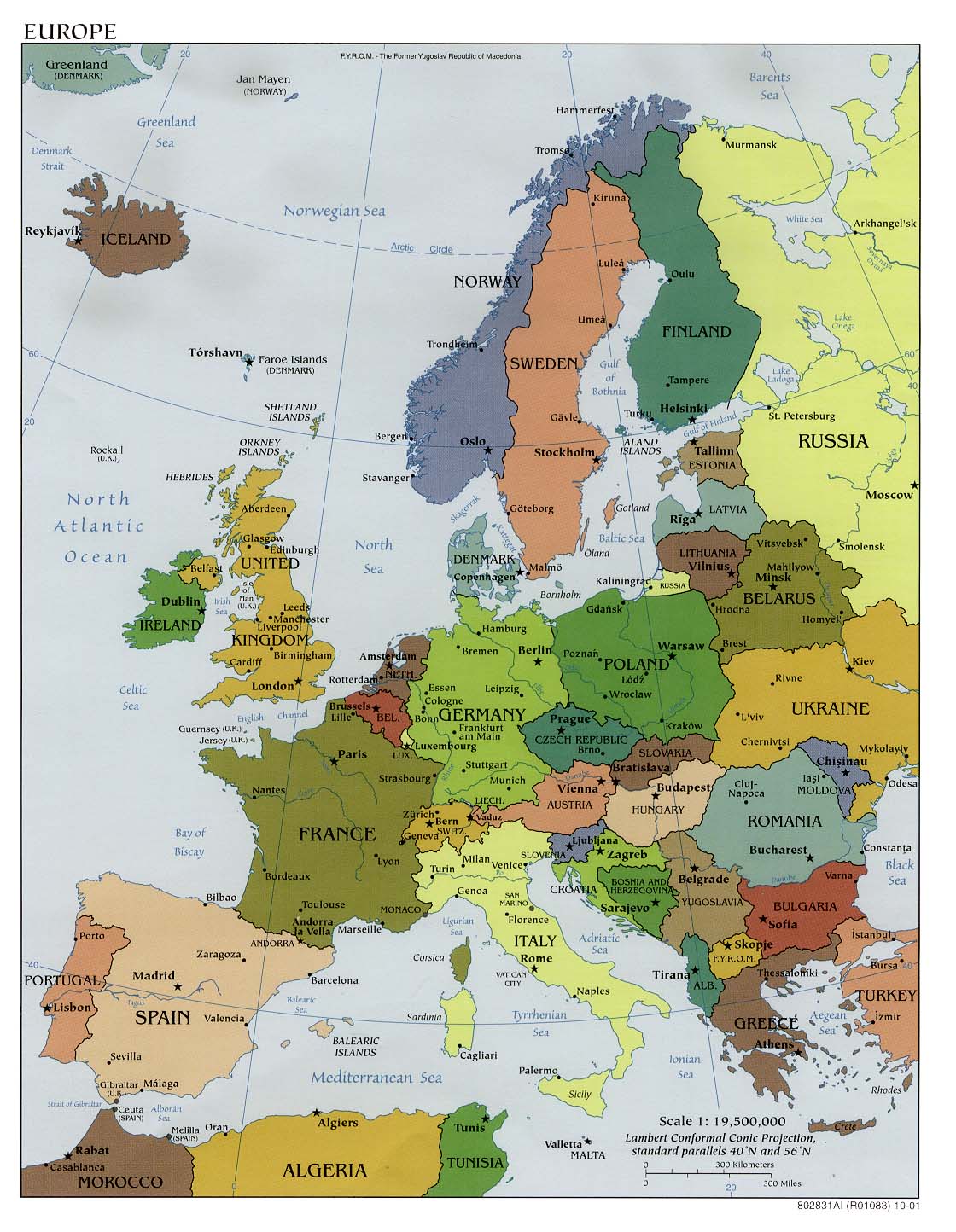
But what if we looked at it this way?
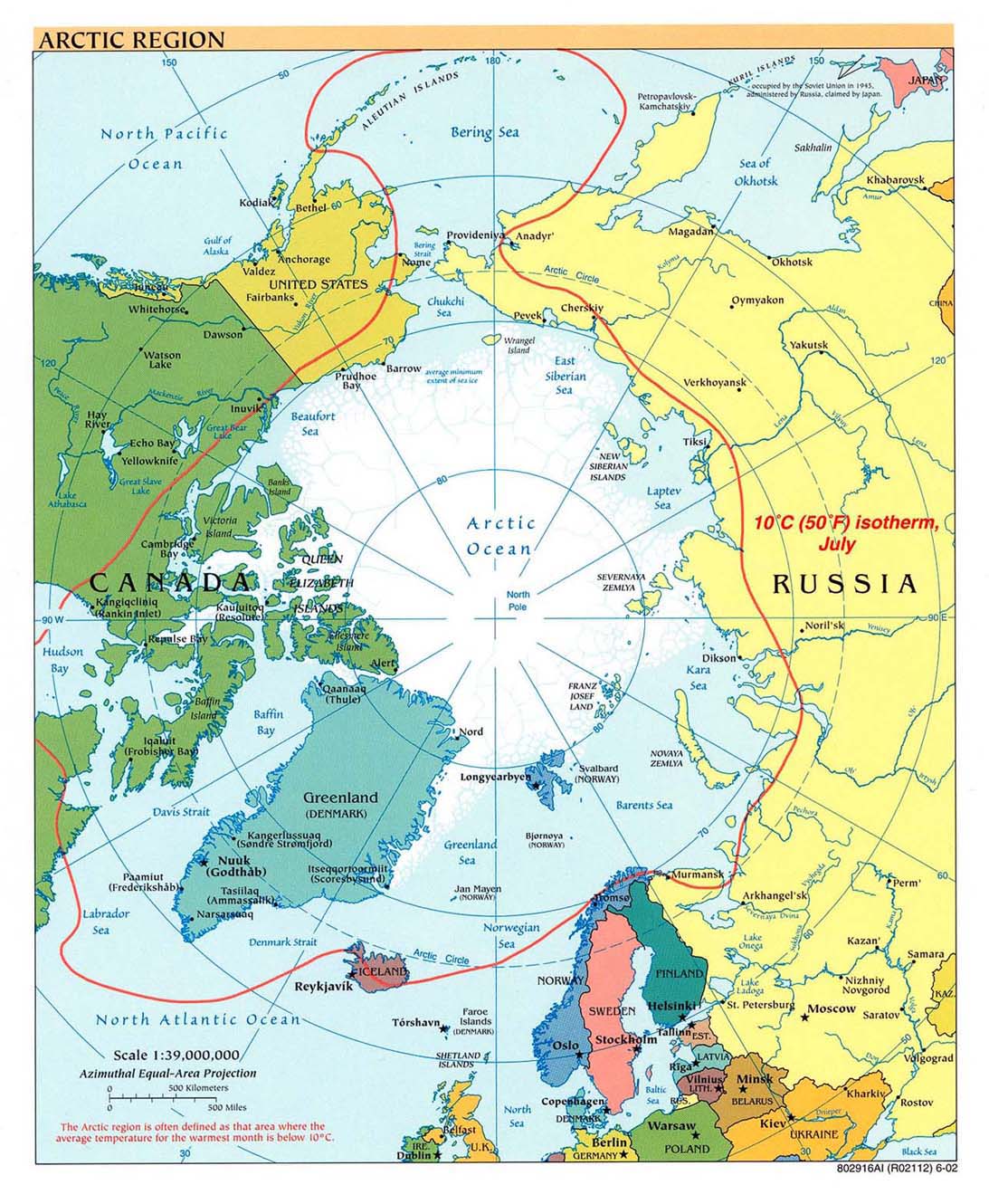
Map borrowed from the Perry Castaneda collection, University of Texas Library.http://www.lib.utexas.edu/maps/polar.html
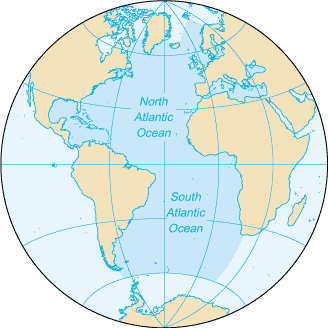
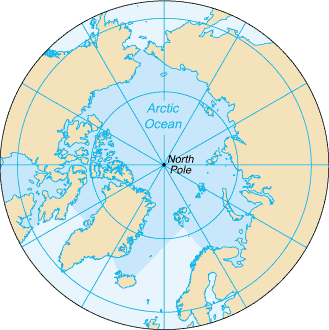
And what if... we looked at the world not as we usually do today (left), but from the North Pole (right)?
http://www.lib.utexas.edu/maps/polar.html
Indeed, there was a time when the world was shaped a bit differently... politically, anyway. The Peoples of Europe, circa 900 AD. Note the 'Northmen", "Jutes", "Angles", "Danes".
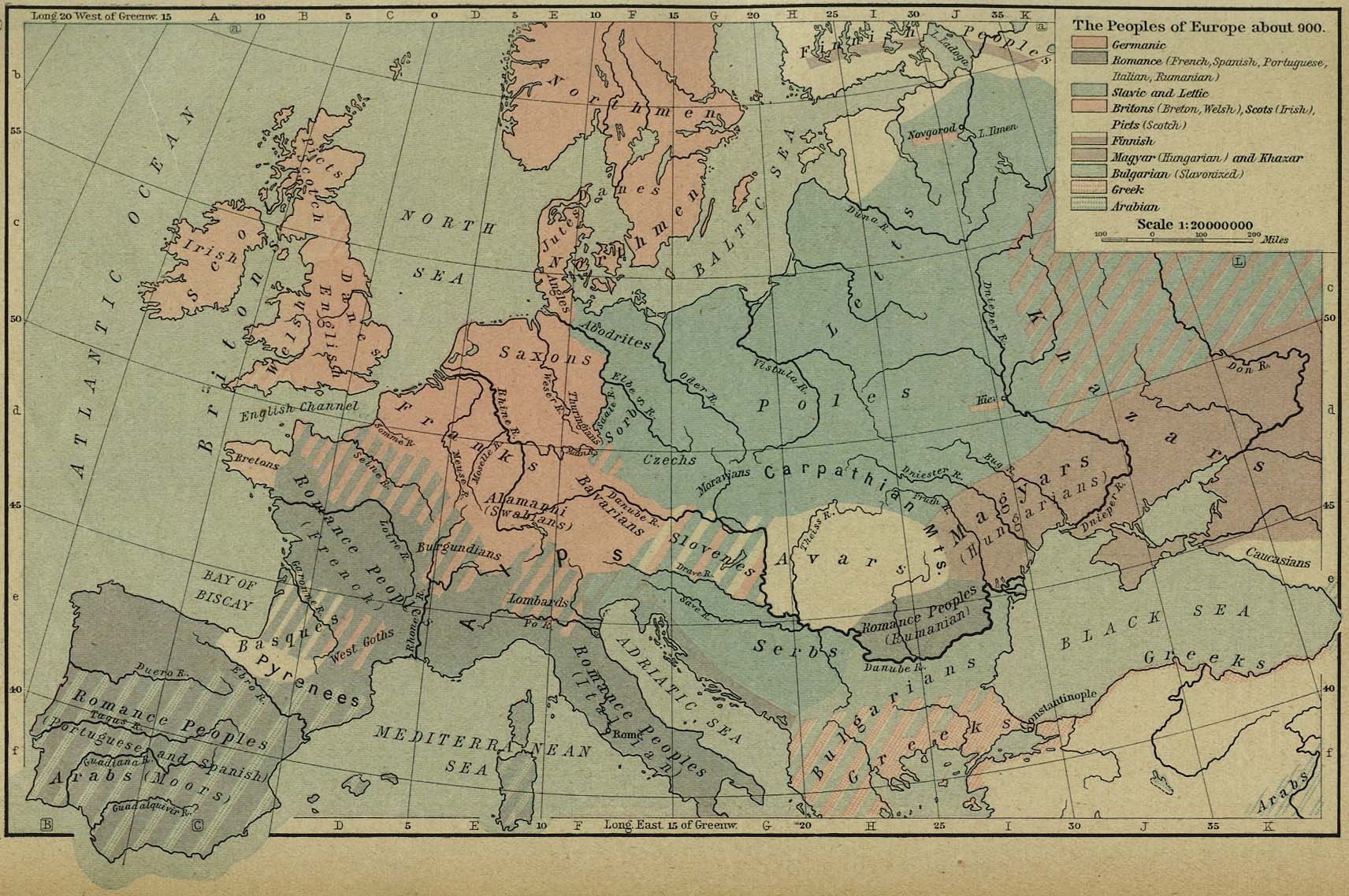
http://www.lib.utexas.edu/maps/historical/shepherd/europe_peoples_900.jpg From The Historical Atlas by William R. Shepherd, 1926.
So, who were the "Vikings"?
Scandinavian, Germanic, Vikings, Norse.... Danes, Svear, Goths, Norwegians
When was the Viking Age?
They were raiding, trading, settling around Europe from A.D. 793-1066... though the people themselves did continue on after that. (dates are a bit arbitrary)
Why were they roaming around?
- overpopulation, political instability, warfare, religious/cultural changes... plus they had great boats for trading, viking
And how far did they go, a-trading and a-viking?
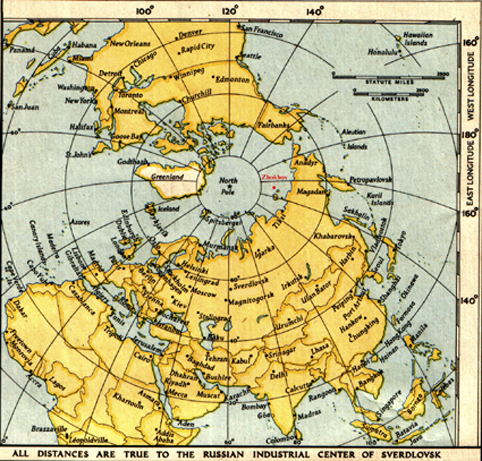
More on Medieval Commerce? http://www.lib.utexas.edu/maps/historical/shepherd/europe_mediaeval_commerce.jpg
What happened to the Vikings in the end?
- in many places, settled, blended in and transformed. In others, they maintained a distinct society. And in other places, they disappeared...
The Norse in the North Atlantic
The extent of their travels in this area...
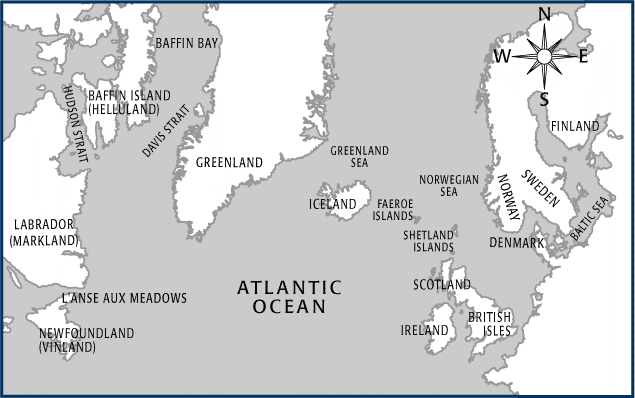
http://www.mnh.si.edu/vikings/learning/map.html
The Viking Voyages to the New World
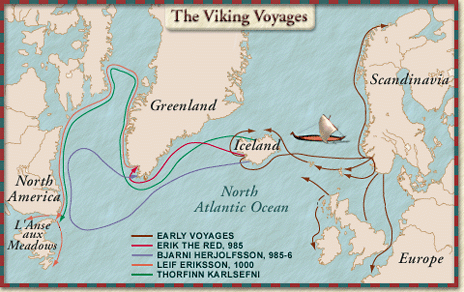
Image: http://www.mnh.si.edu/vikings/start.html
How did they travel? Some Viking boats
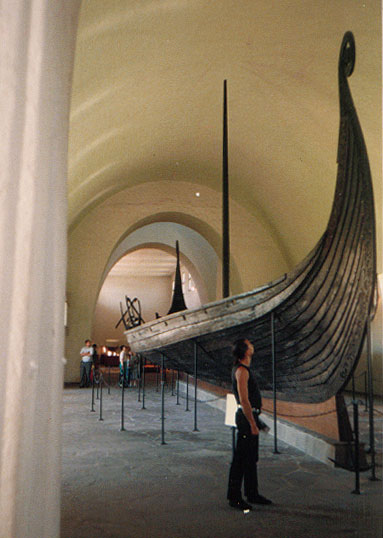
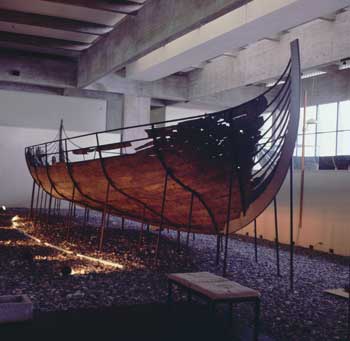
Right/Above: Knarr (merchant boat)
photo: http://www.vikingeskibsmuseet.dk/main/page.asp?sideid=243
Left: Longship (war boat)
(Photo by Jude Fisher: http://www.judefisher.co.uk/gallery_fgs.htm)
Longship, left: the Gokstad ship, which was used as a burial for a chieftain in Norway c. 900 AD. (32 oars, ship could sail at 12 knots - a replica was sailed across the Atlantic in 1893)
Knarr, right: Skuldelev 1. A knarr - a trading vessel. Able to carry up to 24 tonnes of cargo, and to sail at up to 13 knots. Crew: 6-8. Built around 1030 AD, in Western Norway. Wreck recovered from Roskilde Fjord, Norway. A replica, Snorri, sailed Leif Ericson's probable route in 2000.
knot = nautical mile. 12 knots/hour = 22 km/hour = 533 km/day! if the wind is consistently right, that is...
How do we know about the Vikings?
Different lines of evidence include...
Sagas - oral narratives written down 200 years or more after they originated
Historical documents - initially, written about the Vikings by other people... primarily monks. Later, after the Norse converted, they wrote records too.
Genetics - modern distribution of genetic traits
Inuit oral traditions
Experimental archaeology/reconstruction
ARCHAEOLOGY!
- burials, including skeletal analysis and grave goods e.g. jewelry, clothing, tools,
- domestic sites, including houses and middens, food, games
- lifeway information from farms, workshops etc.
- religious sites and objects
- underwater archaeology, including ships
- zooarchaeological analysis (of food animals)
- pictures from stone carvings, tapestries etc.
- palaeoenvironmental studies through ice cores, animal bones, seeds and pollen, insects
The Norse in Greenland
Locating ourselves in time: Timeline of occupation in Greenland

Source: http://www.sila.dk/History/Norse/Start.html
So the Norse were not alone! Who else was there?
The Norse were preceded and superseded in this region by the native peoples of the Arctic. The Dorset culture had occupied the Eastern Arctic (from Hudson Bay, east) since 900 BC. However, the late Dorset people only lived at the northern edge of Greenland, and there isn't evidence of direct contact with the Norse. The Thule culture, by contrast, originated in Alaska around 1000 AD, and then swept across the Arctic, reaching Greenland in approximately 1200 AD. They lived in many parts of coastal Greenland, and came into contact with the Norse. The Thule continued to live there after the Norse disappeared, and their descendants still do today.
Locations of Norse settlements in Greenland
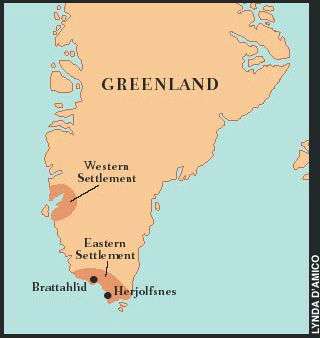
Two settlements:
Eastern Settlement
Western Settlement
- mainly dispersed farmsteads
Image : http://www.archaeology.org/online/features/greenland/index.html
Similarities to pattern on Greenland today: http://www.lib.utexas.edu/maps/cia03/greenland_sm03.gif
What the sites look like today
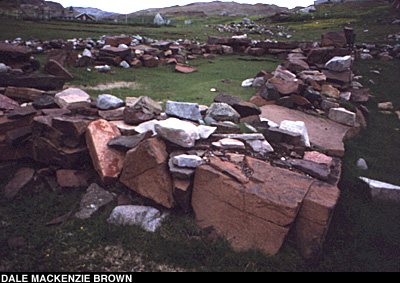
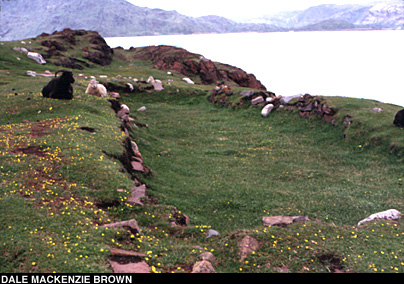
Left: Ruins of a small Norse church in Greenland. Image: http://www.archaeology.org/online/features/greenland/index.html
Right: Ruins of the Great Hall of the Western Settlement. Image: www.archaeology.org/online/features/greenland/index.html
An aside: The Vinland Episode
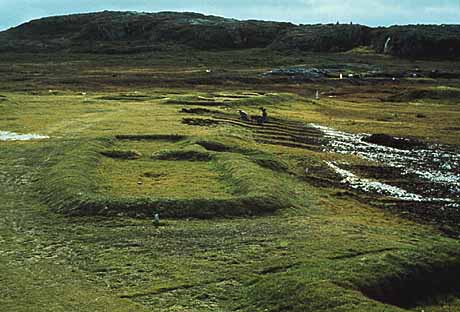
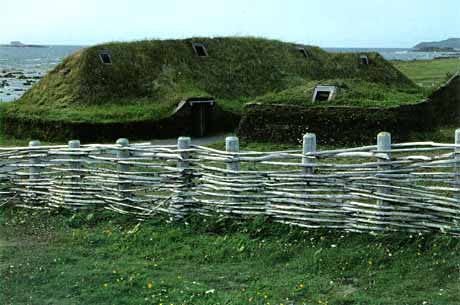
Left: L'Anse Aux Meadows, Hall D. Site as found, not reconstructed. http://www.heritage.nf.ca/exploration/hall.html
Right: Replica of sod house at L'Anse Aux Meadows, Nfld. http://www.heritage.nf.ca/exploration/meadows.html
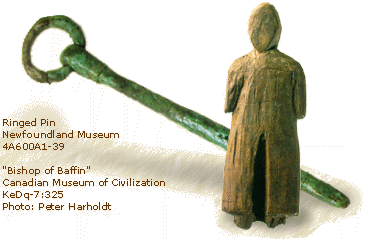
Norse-related Artifacts in Canada
Viking-made pin from L'Anse Aux Meadows.
Inuit-made figurine from Baffin Island Inuit site, representing a Viking?
http://www.mnh.si.edu/vikings/1137.html
Norse Life in Greenland
For a time, things went well...

Greenland in the summer. http://www.mnh.si.edu/vikings/voyage/htmlonly/greenland.html
Also view reconstructions of the settlement at Brattahlid. http://www.greenland-guide.gl/leif2000/reconst.htm
The Norse farms were successful. For hundreds of years, the settlements survived. They traded with Europe. They built churches. They even ironed.

"Glass Smoother [not shown] and Whalebone Ironing Board
text and image from: http://www.mnh.si.edu/vikings/1135.html
But then something went very wrong.
Why did the Norse on Greenland disappear? What happened to them?
A team of archaeologists, together with other scholars, have been working to solve the mystery.
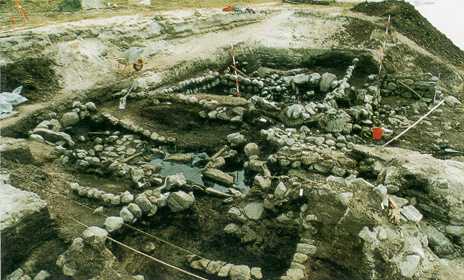 Archaeological Site: Farm Beneath the Sand.
Archaeological Site: Farm Beneath the Sand.
"
After three years of excavation, the Farm Beneath the Sand site began to take shape as rooms and passageways were revealed. It became clear that the front of the farm (to the right) had been eroded by the river; fortunately the river sands that covered the site had sealed it from the air and caused permafrost to preserve everything. Photo: J. Berglund" http://www.mnh.si.edu/vikings/voyage/subset/greenland/archeo.html
What have the researchers learned from this investigation and others like it?
There have long been a host of different theories explaining the disappearance of the Greenland Norse.
(What do you think?)
The theories have included
-plague (Black Death)
- kidnapped by pirates
-intermarried with Inuit
-warred with Inuit
-famine
-Ice Age/climate shock
-overgrazing
-erosion of farmland
-failure to adapt (clothes, rigid religion)
-environmentally expensive lifestyle
-dysfunctional economy and religious strictures
-last ones sailed away, drowned at sea? landed elsewhere?
Archaeologists and allied researchers have examined evidence like this:
-sagas and other historical documents, e.g. church documents - historians
-arch. sites (graveyard, middens, farm dwellings, churches) archaeologists
-preserved clothing
-350 human skeletons – forensic pathologist
-fossilized insects (e.g. flies from farmhouse, beetles from hay field, flies from midden) palaeoecologist
-ice cores
-mud cores from lake beds (erosion)
- animal bones arch/faunal analyst
- ethnographic data historians, anthropologists, archaeologists
- Inuit mummies
And they have performed these kinds of analysis:
-translation and study of documents
-excavation and retrieval of material remains
-mapping of settlements
-identification of animal bones (and analysis of type, frequency, butchery patterns)
-entomological analysis under microscope, including identification of species and counts of frequency
-ice core and teeth – Oxygen Isotope Analysis
-ice core – deuterium variance analysis
-clothing analysis of style, warmth, etc.
-analysis of human remains: age, sex, health
The researchers' findings?

Skeletal analysis
- declining life expectancy, average life span 30-35, closer to 30 in the later years
- middle ear disease/infection increases in frequency over time
- young adult females and children over-represented in graves
- tooth oxygen isotope analysis confirms that they lived through a weather shift
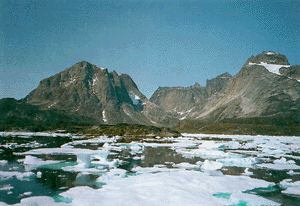
Climate Change: The example of drift ice
"Sea ice is a major hazard to navigation during the summer in southern Greenland, as seen in this photo taken in Anodliuitsog in 1995... Paleoclimatic and documentary evidence indicates that summer ice was rare or absent during the Viking period. Modern drift ice conditions probably began in South Greenland around 1300."
Photo: J. Lindbergh, New York. Caption and image from: http://www.mnh.si.edu/vikings/voyage/subset/greenland/environment.html

Culture: Refusal to adapt?
"Herjolfsnes Hood.
This woolen hood was excavated from a churchyard in Greenland dating to the late 14th century. The distinctive long “tail” on the end of the hood was fashionable in Europe around the same time, indicating that Greenlanders were keeping up with European fashion in the midst of a cooling climate and decreasing trade contacts." text and image from: http://www.mnh.si.edu/vikings/1138.html
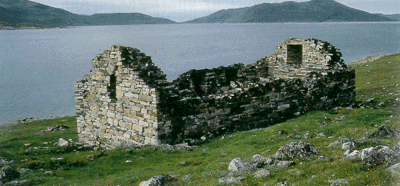 Religion:
help or hindrance?
Religion:
help or hindrance?
"
Hvalsey Church, Eastern Settlement: In 1408 a wedding was recorded at the Hvalsey Church, but that was the last word to come from Greenland; after that was silence. Photo: J. Lindbergh, New York"Image and caption: www.mnh.si.edu/vikings/voyage/subset/greenland/history.html
So what happened to the Norse Greenlanders? and what does it all mean?
Further Reading
Online sources about the matters above...
Brown, Dale Mackenzie. 2000. The Fate of Greenland's Vikings. In Archaeology magazine online, February 28, 2000: http://www.archaeology.org/online/features/greenland/index.html
The Norse in the North Atlantic: www.heritage.nf.ca/exploration/norse.html
Vikings: The North Atlantic Saga. Great site to explore thoroughly from the Smithsonian Institution: http://www.mnh.si.edu/vikings/start.html
McGhee, Robert. 1988. "The Vikings: They Got Here First but Why Didn't They Stay?", Canadian Geographic. Volume 108, Number 4. Available online at: http://www.collectionscanada.ca/north/h16-4223-e.html
Sila, The Greenland Research Centre at the National Museum of Denmark. www.sila.dk/History/Norse/Start.html Research site explaining recent findings on the archaeology of Greenland. Includes not only the Norse, but also the Native peoples of the Arctic, including the Dorset and Thule.
The Lost Vikings of Greenland, PBS video and website: http://www.pbs.org/wnet/secrets/html/e2-menu.html
Eric the Red's saga: http://www.collectionscanada.ca/north/h16-4207-e.html
Additional interesting sources about the Vikings
The BBC's Viking site gives good coverage about Viking incursions/settlements in England. http://www.bbc.co.uk/history/ancient/vikings/
Interesting collection of old maps (1600 onwards) of the polar regions, from the University Library of Tromsø, Norway. It's fascinating to see how the understanding of the polar regions has changed so much over the last several hundred years. http://www.ub.uit.no/northernlights/eng/maps00.htm
A remarkable example of a Viking "hoard" (a storage deposit left in antiquity, and never recovered... until recently!), at the British Museum, may be viewed here.
Does your name end in "son"? Is your family from Britain originally? This map may be of interest: http://www.ling.upenn.edu/~kroch/scand/viking-slides13.jpg. The "son" naming system is Scandinavian originally... and the highest number of names ending in "son" in England corresponds to the ancient pattern of Norse invasions and settlements there.
The Viking Ship Museum, Denmark: http://www.vikingeskibsmuseet.dk/default.asp?contentSection=2 This site includes some great film clips.
Reconstructed Viking Ships: http://www.abc.se/~m10354/bld/replicas.htm
York/Jorvik, an archaeologically excavated and restored Viking site in the north of England: http://www.ling.upenn.edu/~kroch/scand/viking-slides2.jpg, http://www.jorvik-viking-centre.co.uk/trialsplash2.htm, http://www.yorkarchaeology.co.uk/artefacts/aa_frameset.htm
An interesting case of Viking bioarchaeology: Should we trust the sagas as accurate? Egil the Viking http://www.viking.ucla.edu/Scientific_American/Egils_Bones.htm
The Runic Alphabet: http://www.mnh.si.edu/vikings/learning/runes.html
And run, don't walk, to the library to take out a volume of Norse Sagas!
Related Current Issues
Please don't buy a Viking sword online: www.thestate.com/mld/thestate/business/8659291.htm (Why not? The illegal antiquities trade encourages the destruction of archaeological sites, sadly.... http://www.mcdonald.cam.ac.uk/IARC/Display/Interactive.htm)
The Vikings are invading Canada again! Sort-of : ) There's a little island called Hans Island, between Ellesmere Island and Greenland, the ownership of which is disputed... http://www.naval.ca/article/Heubert/The_Return_of_the_Vikings.html
p.s. Want more Viking Fun?
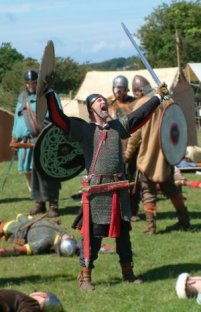
Visit "The Vikings": A Reenactment Society, founded 1971, England: http://www.vikingsonline.org.uk/
Too scary? Well, there's always Playmobil...
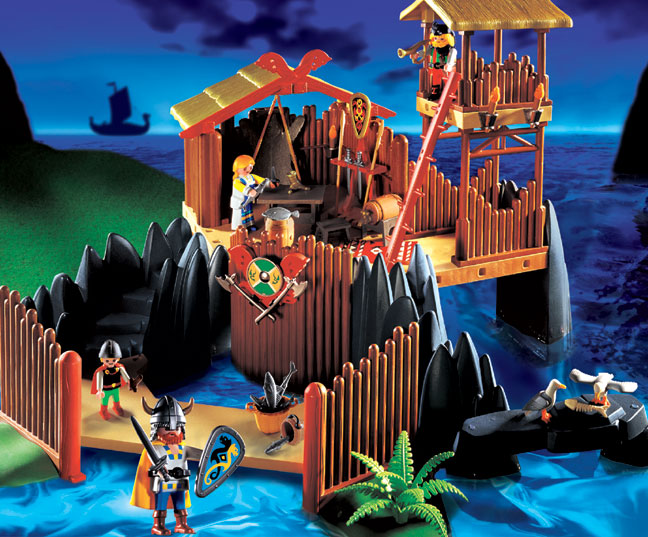
Yes, Playmobil Vikings! (Note the historically inaccurate hat.) Part of the quite delightful Playmobil Viking series, complete with Longship...
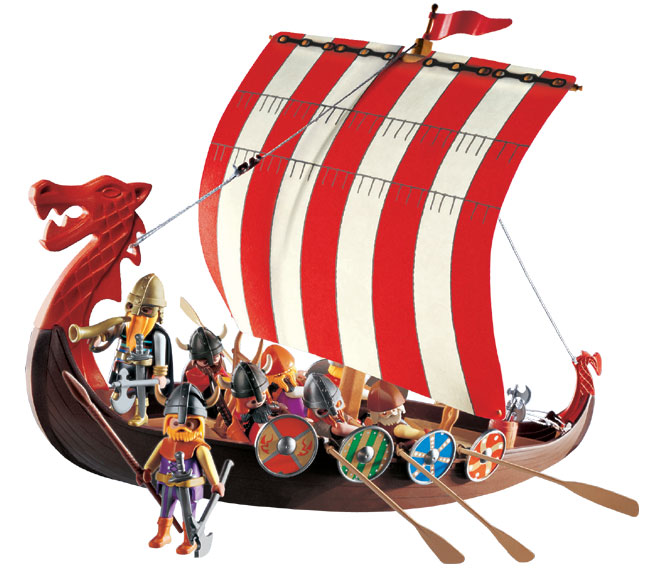
Want to see more? Visit: www.mailorderexpress.com/PlaymobilShop/historical_warrior.html